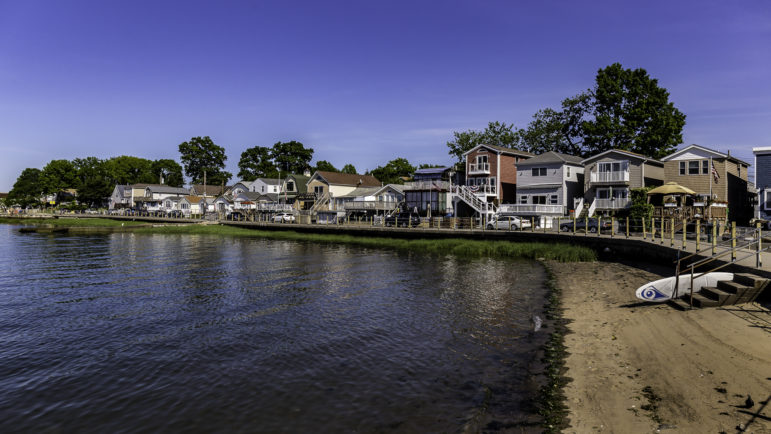Join City Limits at the 2022 Waterfront Conference, a day-long event of speeches and panels by experts in resiliency, housing, and policy to address approaches to the climate crisis that range from federal policy to hyperlocal solutions.

Adi Talwar
View of the Northern shoreline of Edgewater Park in the Bronx.Nearly 10 years after Superstorm Sandy pummeled New York and New Jersey’s coastlines, causing an estimated $19 billion in damages and economic losses, the city’s waterfront remains especially vulnerable to storm surges.
This threat will only increase as extreme weather events become more intense and more frequent, and as sea levels continue to rise, according to the United Nations’ Intergovernmental Panel on Climate Change, which released its most recent and dire report in February highlighting the need for immediate global action to reduce greenhouse gas emissions and build resiliency.
“With increasing global warming, losses and damages increase and become increasingly difficult to avoid, while strongly concentrated among the poorest vulnerable populations,” the authors wrote.
This and other urgent issues will be the focus of 2022 Waterfront Conference on May 24, a day-long event of speeches and panels by experts in resiliency, housing, and policy to address approaches to the climate crisis that range from federal policy to hyperlocal solutions. The conference—which is is organized by the Waterfront Alliance, and of which City Limits is a sponsor—will be held in-person 8:30 a.m. to 5 p.m. at the Museum of Jewish Heritage at 36 Battery Place in Lower Manhattan.
It will feature Columbia University Earth Institute and NASA scientist Dr. Christian Braneon, who will highlight how the effects of climate changes, such as heat waves and flooding, disproportionately affect vulnerable populations, including communities of color. Braneon recently released results of a study he collaborated on, which involved collecting data on heat islands in Manhattan and The Bronx and examining how they intersect with areas mostly populated by communities of color and low-income residents.
Other highlights include a talk on challenges in the labor market related to off-shore wind, a panel on climate anxiety and grief and a discussion on climate resiliency in public housing. City Limits will also moderate a panel on youth climate activists and the immense pressure they’re under to push adults to enact measures that afford them a livable planet in the future.
The stakes are high: by 2100, New York City could see its sea level rise by six feet, some models predict.
New York legislators have taken some steps to address the climate crisis at the local and state level. Last month, the state’s Public Service Commission approved two major renewable energy projects that combined are expected to reduce New York’s reliance on fossil fuels by half. The Climate Action Council is currently holding public hearings related to the implementation of the state’s aggressive climate law, the Climate Leadership and Community Protection Act.
And at the city level, Council is considering a number of measures related to climate and resiliency, including a bill to create a streamlined Department of Sustainability and Climate Change as a way to reduce red tape as the city braces for the next superstorm. Last December, the city’s Department of City Planning released its 10-year Comprehensive Waterfront Plan, which presented a nearly 300-page roadmap to improve access to and resiliency of the city’s 520 miles of waterfront. The report noted the need for city officials to make land-use policies with climate resiliency and risk in mind, complete projects still pending since Superstorm Sandy and focus on resilient design going forward.
To see the full schedule for the Waterfront Conference, buy tickets or to read more about the event, visit the website here.









